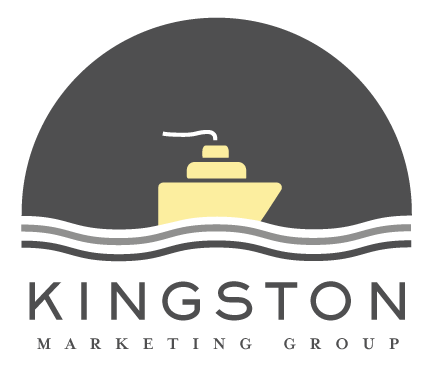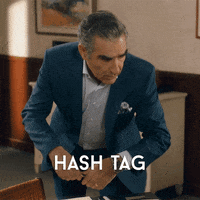KMG Hot Take: #AreHashtagsDead?
By Jillian Henrichs, Marketing Manager
I have a confession: I think hashtags are dead.
Ok, “dead” might be a little dramatic.
Hashtags are still around, but how we use them today, as customers and brands, has changed quicker than an anamorphosis character. As someone with over a decade of experience in Social Media, I think it’s time to get this hot take off my chest.
Before I raise alarms for my fellow millennials who are writing and rewriting those Instagram captions to strike the perfect balance between #Effortlessness and #Wit, let me impart some seemingly random, yet helpful, facts about our beloved # symbol to ground us. (This will also provide you with knowledge for your next trivia night.)
The hashtag symbol dates back to Roman times as an abbreviation for writing libra pondo, or lb, over and over again when weighing things¹
It’s actually called an “octothorpe²” 🤯
The symbol was added to the dial tone telephone in the 1960s³
It indicates a sharp in music⁴
Proofreaders sometimes use it to designate the insertion of a space⁵
Computer coders can use it to mark comments or commands in programming language⁶
Social Media History
So with all of those actual uses, how did social media take hold of the # symbol so strongly? The rumor goes that a person named Chris Messina started the hashtag as we know it today on Twitter in 2007. He simply wanted a way to group tweets and have a “better eavesdrop experience on Twitter⁷” (RIP little blue bird). And, with up to 60,000 tweets being sent in a day by the end of 2007, there was a lot of chatter ripe for eavesdropping. The intent was to have a way of grouping keywords for news, events, and interests that would be aggregated together.
Uniquely, this collection method became ubiquitous and was soon used on multiple, non-connected social media platforms. Most major platforms such as Instagram, Facebook, TikTok, Twitter, LinkedIn, YouTube, and Pinterest have hashtag labeling and cataloging built into their platforms.
Hashtags for Social Media Marketing
What was used to categorize news and events in 2007, quickly became a cultural norm and also took shape as a marketing tool. Soon after its initial use, businesses used the hashtag as a tool to:
Organically enter into conversations with target audiences using grouped terms like #tents or #hikingboots. (This is still in use, but with more specificity. I go into detail later.)
Create branded marketing campaigns associated with a specific product or seasonal campaign. Take #REI1440Project for example. Over 4 million posts are using the hashtag which was started by REI as a campaign and tribute to the 1,440 minutes in a day someone can use to get outside. ⁸
Conversely, many consumers use hashtags to be part of conversations about brands. For example, some of the top brands in the world are drowning in hashtags on Instagram- #nike is found in 118,388,403 posts and #apple is found in 45,964,688 posts! Consumers often do this as a way to:
Get noticed as an influencer by brands such as Nike or Apple who may use these hashtags to find imagery and ask users if they can then post their relevant photos on their brands’ feed. (This is also known as a form of User Generated Content.)
Help other consumers know about features and fails of products or business locations. Maybe you want to know about a specific new technology or learn if a certain restaurant is worth visiting.
Present Day Hashtag Use
The crux of my hot take about hashtags now being (kind of) dead comes at the shift in many social media apps’ UX and the evolution of how consumers use social media today.
New app features make some of these previous uses irrelevant. Instagram released tagging accounts within brands, eliminating the need for some hashtag uses that call out brands or places. Additionally, hashtags aren’t even clickable in Instagram Reels captions.
Younger, social media-savvy generations (Hello, Gen Z) prioritize authenticity and relationships with influencers over big branded content. If hashtags feel like they are selling instead of educating, inauthenticity may be present.
Many people now use social media as a search engine looking for content most relevant to their interests and pain points. This is especially prominent with the rise of TikTok. “Almost 40 percent of young people, when they’re looking for a place for lunch, they don’t go to Google Maps or Search. They go to TikTok or Instagram,” Prabhakar Raghavan, a Google senior vice president said this year. TikTok is currently using hashtags in its algorithm to help categorize the types of videos it shows you.
Some social media platforms, such as LinkedIn, have a very specific purpose; in this case, career and professional development. This means the kind of hashtag used must also be specific to users’ goals for the platform to be beneficial.
These are big changes, so here’s an overview of when and how your brand should use hashtags on 5 prominent Social Media channels today.
As you can tell, hashtags are not totally dead — I admit it. However, the uses have changed from 2012 marketing, and younger generations are inherently using them differently than previous generations. As with all social media marketing, you should keep your target audience core to your messaging. Think about what channels they are on — and for what purpose. From there, tailor your voice and messaging strategies to work with their natural social media norms. You want to talk with them, not at them — and hashtags can help that in a modern social media space. Or you could look like this guy…



